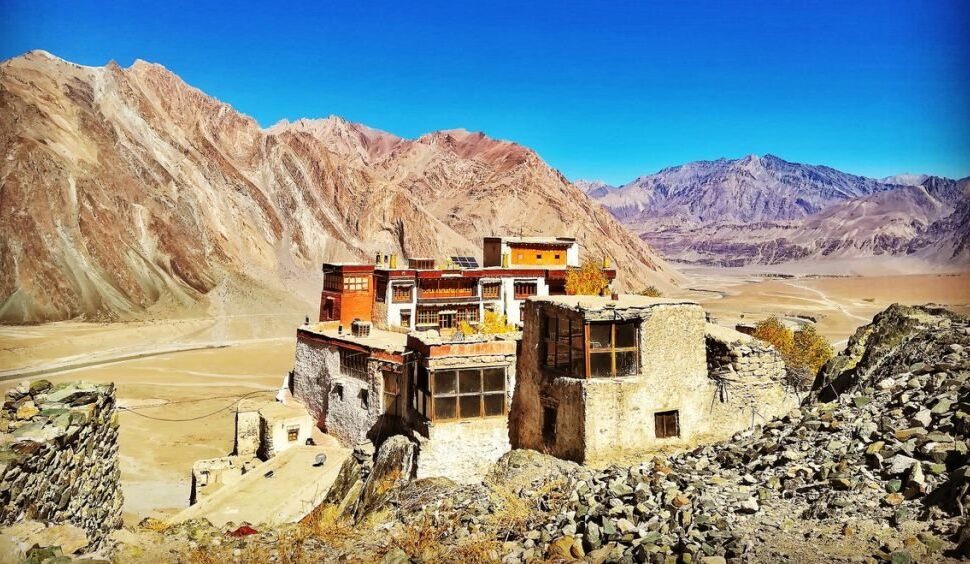Ladakh isn’t just a destination—it’s a living museum of Tibetan Buddhism, where ancient monasteries perch on cliffs, echoing chants drift through mountain air, and centuries-old murals whisper stories of devotion. These gompas are more than architectural marvels; they are spiritual sanctuaries, cultural archives, and timeless symbols of resilience.
Whether you’re a seeker of silence, a lover of heritage, or a curious traveler, Ladakh’s monasteries offer a journey into the soul of the Himalayas
A Glimpse into Ladakh’s Monastic Legacy
Over the centuries, Ladakh has been shaped by dynasties, saints, and scholars who brought with them the teachings of Mahayana and Vajrayana Buddhism. Despite the harsh terrain, monks carved out sanctuaries of peace—some still thriving, others standing in quiet ruin. Today, these monasteries serve as centers of learning, meditation, and cultural preservation.
Must-Visit Monasteries in Ladakh
Diskit Monastery (Nubra Valley)
The largest and oldest monastery in Nubra, Diskit is famed for its towering 32-meter statue of Maitreya Buddha and the vibrant Dosmoche Festival.
- Founded by: Changzem Tserab Zangpo (14th century)
- Timings: 7 AM–1 PM, 2 PM–7 PM
- Entry Fee: ₹30
- Distance from Leh: ~116 km
Hemis Monastery (Hemis Village)
The wealthiest and most celebrated monastery in Ladakh, Hemis is known for its annual masked dance festival and its vast collection of thangkas and relics.
- Founded by: Stag Tsang Raspa under King Singge Namgyal
- Timings: 8 AM–1 PM, 2 PM–6 PM
- Entry Fee: Free
- Distance from Leh: ~40 km
Thiksey Monastery (Leh–Manali Highway)
Often compared to the Potala Palace, this 12-story monastery offers panoramic views and houses a majestic statue of Maitreya Buddha.
- Timings: May–Nov, 7 AM–7 PM (closed in winter)
- Entry Fee: ₹30
- Distance from Leh: ~18 km
Alchi Monastery (Lower Ladakh)
Unlike most hilltop gompas, Alchi sits on flat ground and is renowned for its Indo-Tibetan murals and wood carvings. Photography is restricted inside.
- Founded by: Guru Rinchen Zangpo (10th–11th century)
- Timings: 10 AM–1 PM, 2 PM–6 PM
- Entry Fee: ₹25 (Indians), ₹50 (foreigners)
- Distance from Leh: ~66 km
Spituk Monastery (Near Leh Airport)
Perched on a hill overlooking the Indus, Spituk is known for its fierce Kali statue (revealed only during the Gustor Festival) and its dramatic setting.
- Founded by: Od-de (11th century)
- Timings: 8 AM–1 PM
- Entry Fee: ₹20
- Distance from Leh: ~8 km
Namgyal Tsemo Gompa
Located above Leh Palace, this monastery offers sweeping views of Leh and houses a three-story gold statue of Maitreya Buddha.
Matho Monastery
Famous for the annual Oracle Festival, Matho is the only monastery of the Sakya sect in Ladakh and offers a quieter, more intimate experience.
Takthok Monastery
Built around a cave believed to be used by Guru Padmasambhava, Takthok is the only Nyingma monastery in Ladakh and exudes a mystical aura.
Phugtal Monastery (Zanskar)
Accessible only by foot, this cliffside monastery is one of the most remote in Ladakh. Built into a cave, it’s a marvel of spiritual solitude.
Monastery Etiquette: Respecting Sacred Spaces
To ensure a meaningful and respectful visit, keep these guidelines in mind:
- Dress modestly and remove shoes before entering prayer halls.
- Avoid alcohol and smoking in or near monastery premises.
- Seek permission before photographing monks or sacred objects.
- Observe silence or speak softly—these are places of meditation.
- Follow posted signs regarding restricted areas and photography.
- Respect timings—some monasteries close during lunch or winter months.
Final Thought
Ladakh’s monasteries are not just relics of the past—they are living, breathing sanctuaries of wisdom. Whether you’re watching the sunrise over Thiksey, listening to chants echo through Hemis, or sipping butter tea with a monk in Alchi, you’re not just visiting a monument—you’re stepping into a timeless rhythm of devotion.
Would you like this formatted for your blog CMS or turned into a downloadable travel guide section? I can also help you create a monastery trail itinerary or a map-based visual for your readers.

